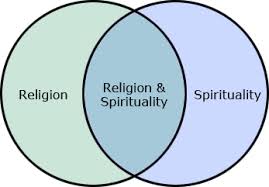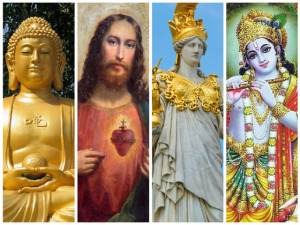Growth of interest in spirituality: Traditionally, spirituality has always been viewed within the framework of a specific religious group. Thus, there have been multiple spiritualities associated with various saints in Roman Catholicism, as well as different spiritual paths to be found within the context of particular interpretations of Buddhism, Islam, and Judaism. In this sense, spirituality has been understood as the concrete set of beliefs and practices by which a person journeyed on a particular religious path. The connection between formal religious structures and spirituality, in this understanding, is integral.
The end of the twentieth century, however, has witnessed new ways of understanding and interpreting the term “spirituality”. Frequently, spirituality is not only independent of any particular sect or religious group but exist completely outside the context of formal religion. Thus, someone can have a “spirituality”without any explicit religious affiliation.
 Arriving at an understanding of this new conceptualisation of spirituality is difficult, since its meaning has been transformed so completely. In fact, it can be argued that there is no longer any single definition that can be given to the term. Undeniably, however, spirituality in this sense represents a significant religious trend. One has only to look at the array of books on spirituality in many book-stores to realise how widespread the public interest is.
Arriving at an understanding of this new conceptualisation of spirituality is difficult, since its meaning has been transformed so completely. In fact, it can be argued that there is no longer any single definition that can be given to the term. Undeniably, however, spirituality in this sense represents a significant religious trend. One has only to look at the array of books on spirituality in many book-stores to realise how widespread the public interest is.
Many of these understandings of spirituality contain common elements. Someone interested in spirituality is seen as having concern with things beyond those of the material world. Spirituality, in this sense, is oriented towards the transcendent, that which lies beyond people’s immediate day-to-day experience. It may involve refinement of thought and feeling, a kind of hightened aesthetic sense; it may have to do with things of the spirit, as contrasted with the body; some would describe it an attempting to find the “source” of everything.
Another element frequently found in descriptions is what might be termed “interiority”or the “inner journey. This implies a significant reflective component, the willingness to enter into rigorous introspection to arrive at self-awareness, and is contrasted with living life at a shallow level, never really coming into contact with one’s “true self” or the deeper realities and questions of human existence.
 Allied to all this, in many instances, is the at least implicit notion of self-improvement. “Spirituality exist to make me a better person,” one might say. In this sense, contemporary understanding of spirituality differ from many traditional definitions, since the goal now becomes focused on self rather than the God. Thus, much of contemporary spirituality tends to be very subjective, in contrast to traditional understandings to which well-defined spiritual paths are followed in order to arrive at specific goals.
Allied to all this, in many instances, is the at least implicit notion of self-improvement. “Spirituality exist to make me a better person,” one might say. In this sense, contemporary understanding of spirituality differ from many traditional definitions, since the goal now becomes focused on self rather than the God. Thus, much of contemporary spirituality tends to be very subjective, in contrast to traditional understandings to which well-defined spiritual paths are followed in order to arrive at specific goals.
These new forms of spirituality frequently both derived from and are tied to wider forces in the contemporary world. For many, especially in the West, traditional mainstream religion is viewed either negatively or with suspicion. Given the rapidity and stress of change in the modern world, however, many people feel a need to anchor themselves in something beyond their own immediate physical realities. Such new ways of viewing spirituality provide for this kind of security without demanding that practitioners belong to a particular religious organisation, which its attendant set of structures. The whole notion of post-modern world, with its critique of scientific rationalism as the only legitimate way of knowing, has further encouraged interest in things not accessible by empirical examination.
Interest in nature, ecology, and a holistic rather than component-oriented attitudes towards oneself and the world have also have been driving force behind the new interest in spirituality. Here the notion of “connectedness”with the world of nature and the desire to see things as organic parts of a whole have become important elements.
 In the West, beginning with Freud, understanding what makes human beings “tick” has been possible without having to make reference to God or religion. This search for the “inner self”, seen in popular psychological and self-help literature, is also a component.
In the West, beginning with Freud, understanding what makes human beings “tick” has been possible without having to make reference to God or religion. This search for the “inner self”, seen in popular psychological and self-help literature, is also a component.
All these factors motivate the search for spirituality. For some, it takes the form of attention to aspects of New Age belief and practice, whether involving meditation or chanting, crystals or angels. Other take up practice like Hindu yoga, Jewish kabbalism and Sufi chanting without necessarily subscribing to the religious for which they originated. Still others develop highly individualised systems of belief and practice.
The success of spirituality literature is testified to by the continual stream of books published in this area. A preliminary search of the Internet for websites concerned with spirituality yields thousands of result , ranging from the spiritualities of Saints John of the cross and Ignatius Loyola to the Institute for Astroenergetic Studies and the Society of Luminists. All of these bear witness to the deep and widespread interest exhibited by many in spirituality without necessarily being rooted in specific religious denominations or sects.
Source: “Recent Trends in Religion” by: F. Michael Perko, SJ
